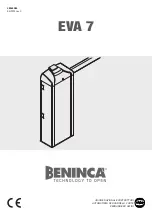
MODULATED INFRARED BARRIER
REMARKS
These instructions are aimed at professionally qualified "
installers of electrical equipment
" and
must respect the local standards and regulations in force.
The use and installation of these appliances must rigorously respect the indications supplied by the
manufacturer and the safety standards and regulations in force.
Attention!
Only for EU customers -
WEEE marking
.
This symbol indicates that once the products life-span has expired it must be
disposed of separately from other rubbish. The user is therefore obliged to either
take the product to a suitable differential collection site for electronic and electrical
goods or to send it back to the manufacturer if the intention is to replace it with
a new equivalent version of the same product. Suitable differential collection,
environmental friendly treatment and disposal contributes to avoiding negative effects on the
ambient and consequently health as well as favouring the recycling of materials. Illicitly disposing
of this product by the owner is punishable by law and will be dealt with according to the laws
and standards of the individual member nation.
Description
Modulated infrared barrier consisting of a projector and a receiver.
The equipment is housed in a shock-proof and waterproof plastic casing. The casing is designed to
be surface mounted on walls; the special anchor plate ("
A
" fig. 1) in rubber permits flush fitting even
on irregular surfaces. The system of diodes (sender - receiver), fitted with a constraint guide for the
infrared beam remains in a fixed position.
The equipment is constructed in conformity with the local standards in force.
Protection grade
IP54
.
Use
The infrared barrier constitutes an efficient safety system for the protection of passageways or spaces
which are equipped with automatic door or gate systems, and for the detection and control of general
passageways, whether carriageway or pedestrian, situated inside or outside buildings.
Suitable for passageway control with a passing room of not more than
10m
.
The use and installation of these devices must respect the safety standards and regulations in force.
The manufacturer accepts no liability for damage caused by, or situations arising from, the improper
use of these appliances.
Versions
CDR861-
The package contains the components required for surface mounted installations:
- 1 transmitter in a basic case
- 1 receiver in a basic case
- set of gaskets
- set of screws
Technical specifications
- Infrared emission obtained through the use of a double emitter
GaAs
(Galium Arsenide) diode with
continuous modulation at
610 Hz
;
- Infrared emission wavelength:
950 nm
;
- Power supply:
12 - 24 Vac/dc
;
- Command: double relay with serial exchange;
- Maximum commutable power of relay with resistive load:
28W
in
dc/60VA
in
ac
; Mmax. voltage
40V ac/dc
- Power consumption:
12V ac/dc
,
30 mA
for the re
40 mA
for the transmitter
24V ac/dc
,
36 mA
for the re
53 mA
for the transmitter
- Operating temperature:
-10…+55°C
;
- Red led indicating that the projector is live.
- Red led and test point for fine tuning the receiver (located in the receiver).
- Range:
10 m
under all weather conditions even where thick fog, rain or dust are
encountered.
Installation
(fig. 2-5)
A)
The projector and receiver are normally positioned frontally on the same geometrical axis and at
the same height from the ground.
- Installation is possible on all types of structure.
Make sure the surface on which the appliance is to be installed is flat and that the structure is linear.
If the above mentioned condition is respected then it will be only necessary to check the height of
the receiver and the transmitter in order to satisfy condition
A
.
For a correct installation carry out the following:
- Choose the points at which the devices are to be surface mounted, depending on the system
requirements.
- Work out the run of the cables on the structure to the connection point.
- Mark the position of the fixing holes using the supplied template.
- Remove the p.c.b. card from the base ("
D
" fig. 2).
- Fix the base to the wall ("
A-B
" fig. 2) and pass the connecting cables through the hole.
- Replace the p.c.b. card and carry out the connections (fig. 3).
- Activate the system and check that it works correctly.
If the structure is irregular then it is recommended that the electrical functioning be controlled before
fixing the appliance. After having fixed the projector, connect the receiver and proceed as follows.
Checking and centring
(fig. 4)
N.B. - When the projector and receiver are activated the projector LED will remain permanently lit;
the receiver LED will be off if the photoelectric cell is centred (system activated) and lit if the cell is off
centre. To check that the photoelectric cells are centred during the installation phase proceed as follows:
1) Insert the probes of a normal tester (lowest setting 2V dc) into the test point maintaining the
correct polarity as indicated on the p.c.b card.
2) Proceed with the measurement using the tester. A signal deviation equal to 0,4 V is to be
considered optimal. Should the tester register a greater deviation the this can be corrected
by fine tuning (until an optimum deviation is obtained) using the trimmer on the receiver.
N.B: No fixed object should be located between the receiver and the projector. If ulterior shock-proof
protection, which interferes with the infrared beam, is to be fitted we advise you to consult one of
our technicians.
BARRIERE A INFRAROUGE MODULE
AVERTISSEMENT
Ce livret est destiné à des personnes titulaires d’un certificat d’aptitude professionnelle pour l’instal-
lation des "
appareils électriques
" et requiert une bonne connaissance de la technique appliquée
professionnellement. L’emploi et l’installation de cet appareil doivent respecter rigoureusement les
indications fournies par le constructeur et les normes de sécurité en vigueur.
Attention!
Seulement pour les clients de l'EU -
Marquage WEEE
.
Ce symbole indique l’obligation de ne pas éliminer l’appareil, à la fin de sa durée de
vie, avec les déchets municipaux non triés et de procéder à sa collecte sélective. Par
conséquent, l’utilisateur doit remettre l’appareil à un centre de collecte sélective des
déchets électroniques et électriques ou au revendeur qui est tenu, lorsqu’il fournit un
nouvel appareil, de faire en sorte que les déchets puissent lui être remis, sur une base
de un pour un, pour autant que l’appareil soit de type équivalent à celui qu’il fournit. La collecte
sélective des équipements électriques et électroniques en vue de leur valorisation, leur traitement
et leur élimination dans le respect de l’environnement contribue à éviter la nocivité desdits équipe-
ments pour l’environnement et pour la santé et à encourager leur recyclage. L’élimination abusive
de l’équipement de la part du détenteur final comporte l’application des sanctions administratives
prévues par les normes en vigueur dans l’État Membre d’appartenance.
Description
Barrière à infrarouge modulé se composant d'un projecteur et d'un récepteur. L'équipement est placé
dans une boîte en plastique antichoc étanche. La boîte est prévue pour être fixée à un mur: sa base
spéciale ("
A
" fig. 1) en caoutchouc lui permet de bien adhérer même sur les surfaces irrégulières. Le
système de diodes (émetteur-récepteur) muni de guidage du rayon lumineux, reste dans une position fixe.
Ap pa reil ré a li sé confor mé ment à la nor me de sé cu ri té.
Degré de protection
IP54
.
Possibilité d'emploi
La barrière à rayons infrarouges est un système efficace de sécurité et de contrôle pour la protection
des passages ou des espaces où sont installés des portes ou des portails automatiques ainsi que pour
le détectage et le contrôle des passages de véhicules ou de piétons situés à l'intérieur ou à l'extérieur
des édifices. Son champ d'application concerne les passages dont la lumière ne dépasse pas
10m
.
Durant l'utilisation et l'installation de ces appareils, respecter impérativement les indications fournies
par le constructeur ainsi que les normes de sécurité en vigueur. Le constructeur ne peut être retenu
responsable des dommages éventuels causés par une utilisation impropre, erronée ou irraisonnée.
Versions
CDR861-
La confection comprend les éléments pour l'application en surface:
- 1 projecteur dans une boîte
- 1 récepteur dans une boîte
- Visseries
- Joints
Caractéristiques techniques
- Emission à l'infrarouge avec diodes
Ga As
(Arséniure de Gallium) à deux émetteurs à modulation
continue
610 Hz
;
- Longueur d'onde de l'émission infrarouge:
950 nm
;
- Alimentation
12-24 Vac/dc
;
- Commande à deux relais avec échange en série;
- Consommation maxi. de commutation du relais avec charge résistive:
28W
en
dc/60VA
en
ac
; tension max.
40V ac/dc
- Absorption:
12V ac/dc
:
30 mA
le réc
40 mA
le projecteur
24V ac/dc
:
36 mA
le réc
53 mA
le projecteur
- Tem pé ra ture de fonc tion ne ment:
-10…+55°C
;
- Voyant rouge de présence courant électrique dans le projecteur.
- Voyant rouge et test point pour le centrage précis dans le récepteur.
- Portée de
10 m
en toutes conditions même en présence de brouillard épais, de pluie ou de poussière.
Installation
(fig. 2-5)
A)
Normalement, on fixe le projecteur et le récepteur frontalement, sur le même axe et à une distance
égale du sol.
- L'installation est possible sur n'importe quel type de structure. Vérifier que la structure sur laquelle
doit être installé l'appareil soit plane et linéaire. Si les conditions sont optimales, il suffit simplement
de contrôler que les fixations du récepteur coïncident bien avec celles du projecteur jusqu'à ce que
l'on atteigne la condition A.
Pour effectuer correctement la pose, suivre attentivement les indications suivantes:
- Choisir les points de fixation selon la nécessité de l'installation.
- Prévoir le parcours des câbles sur la structure pour qu'ils arrivent jusqu'aux points de fixation.
- A l'aide du gabarit de perçage se trouvant à l'intérieur de l'emballage, tracer les points de fixation.
- Dégager le circuit de la base ("
D
" fig. 2).
- Fixer la base sur le mur, passer les câbles de raccordement dans le trou prévu à cet effet ("
A-B
" fig. 2).
- Replacer le circuit sur la base et effectuer les connexions (fig. 3).
- Une fois terminée l'installation, vérifier qu'elle soit efficace. Contrairement, si la structure est irrégu-
lière, il vaut mieux contrôler le fonctionnement électrique avant de fixer définitivement les appareils.
Raccorder et fixer d'abord le projecteur puis raccorder le récepteur et rocéder ensuite de la façon
suivante.
Contrôle et mise à point
(fig.4)
N.B.: Quand le projecteur et le récepteur sont allumés le voyant du projecteur reste allumé en perma-
nence; le voyant du récepteur s'éteint quand la cellule photoélectrique est centrée (système actionné)
et s'allume quand la cellule photoélectrique n'est pas centrée.
Pour vérifier le bon centrage durant la pose, procéder de la façon suivante:
1) Introduire les points d'un testeur ordinaire (maximum de l'échelle 2 Vdc) dans les zones spé-
ciales d'essai (test point) en respectant la polarité exacte comme indiqué sur les marques se
trouvant sur le circuit imprimé.
2) Effectuer la lecture sur le tester en considérant comme optimale une déviation du signal
égale à 0,4 V. Dans le cas où l'on mesurerait une déviation supérieure, atténuer le signal en
agissant sur le relatif trimmer du récepteur jusqu'à ce que la déviation du signal soit reportée
à la valeur optimale.
N.B.: Aucun élément fixe ne devra s'interposer entre le récepteur et le projecteur.
S'il est nécessaire d'installer des protections antichoc interférant avec le rayon, il est conseillé de
consulter un de nos techniciens.
ENGLISH
FRANÇAIS






